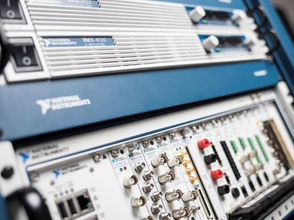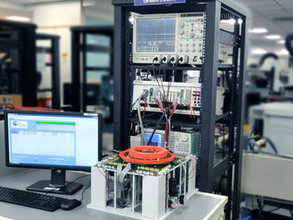top of page

Project Case Studies
The best way to get to know us is by taking a tour of the systems we've developed over the years.
Here is a small sample of some of our Automated Test Systems, Embedded Control Systems, Machine Vision Systems, and Manufacturing Automation Systems.
Project Case Studies by Application Area
Automated Test
Machine Vision
Industrial Automation
Real-Time & Embedded
All Project Case Studies
Search

Precision Control System Advances Global Health
Pharma machine builder collaborated with Cyth Systems to deliver equipment for vaccine production, outperforming product quality and cost of

Biotech Startup Accelerates Funding with Scalable Reference Design
Biotech startup secured funding by demonstrating a bioreactor proof-of-concept in 3 months using Cyth’s embedded control system architecture

Controlling a Stepper Motor Using the RIO Platform and LabVIEW
Stepper motors are widely used in applications requiring precise control of position and speed, such as robotics, CNC machines, and...

National Instruments NI-TClk Technology for Timing and Synchronization of Modular Instruments
Overview Many test and measurement applications call for the timing and synchronization of multiple instruments because of the limited...

An Overview of the PXI Platform
Powered by software, PXI is a rugged PC-based platform for measurement and automation systems. PXI combines PCI electrical-bus features...

Power Line Monitoring Using PowerFlex
PowerFlex - Power Line Monitoring & Measurement System PowerFlex is a ready-to-use platform for energy monitoring and measurement of...

E-Bike Battery Testing and Validation Using BatteryFlex
E-Bike Battery Testing and Validation is performed using the BatteryFlex platform. Project Summary A Southern California E-Bike...

Test and Analysis of Portable Ventilator Battery - BatteryFlex
BatteryFlex platforms battery tests and analysis of portable ventilator batteries. The Challenge A healthcare provider and manufacturer...

Bed of Nails Fixture for Printed Circuit Board (PCB) Testing
Bed of Nails test Fixture used to test embedded control circuit boards. The Challenge We required a fixture to test and measure the...

Bed of Nails PCBA Test of Bluetooth Earpiece Accelerates Path to Market
Bed of Nails PCBA Test of Bluetooth Earpiece Project Summary A consumer electronics provider required a system to test the control...

Circaflex & NI Single-Board RIO Power Syringe Lubrication Inspection Demo
Circaflex and NI Single-Board RIO control the syringe lubrication inspection demonstration. The Challenge A pharmaceutical test and...


How CompactRIO Compares to a PLC
Introduction In the world of industrial automation and control systems, the choice between different hardware platforms can be a critical...

Control System for Hotbar Bonder in X-ray Sensors using LabVIEW & CompactRIO
Custom soldering fixture. The Challenge A manufacturer of custom soldering fixtures approached us with the need for a system to control...


Hyundai Improves Production Test Time using PXI, LabVIEW, and TestStand
Hyundai Kefico ECU Functional Test Fixture The Challenge We needed to sustainably meet manufacturing test deadlines for increasingly...


Probing of Large-Array, Fine-Pitch Microbumps for 3D ICs
Fully Automatic Test System to Evaluate Microbump Probing The Challenge Performing die tests prior to stacking 3D ICs to achieve...

Increasing Automation to Reduce Post-Silicon Characterization by Over 60%
*As Featured on NI.com Original Authors: Vinodh J Rakesh, Cypress Semiconductor Technology India Pvt. Ltd. Edited by Cyth Systems The...


Bullet Train Test using LabVIEW & TestStand Software
Bullet Train Test. The Challenge High-speed and commuter trains are extremely complex systems with thousands of components. The...

PXI Instrumentation for Partial Discharge Monitoring of Hydro Generators
Using PXI hardware for a monitoring & analysis system of hydroelectric power plant generators. The Challenge Cepel needed to implement an...

Double Decker Hybrid Powertrain Monitored Using Circaflex Embedded Controls
Vantage Power's Hybrid Double Decker Bus featuring Cyth’s Hybrid Management System (HMS). The Challenge Retrofitting the drive trains of...

Specialized Bicycles & the Science of Cycling Speed Using Data Acquisition
*As Featured on NI.com Original Authors: Chris Yu, Specialized Bicycle Components Edited by Cyth Systems The Challenge In a sport where...


Creating a Caterpillar System Integration Test Bench
*As Featured on NI.com Original Authors: Chris Thoroughgood, Austin Consultants Edited by Cyth Systems The Challenge Developing a...

Targeted Drug Delivery Using Ultrasound Beam Focusing & LabVIEW
*As Featured on NI.com Original Authors: Dave Lines, Diagnostic Sonar Ltd Edited by Cyth Systems The Challenge Driving and optimizing a...


Improving Scalability of a Satellite Receiver Using PXI Hardware
*As Featured on NI.com Original Authors: Smruti Ranjan Panigrahi, Indian Space Research Organization Edited by Cyth Systems The Challenge...


Rapid Prototyping of an Integrated Starter Generator Using cRIO
*As Featured on NI.com Original Authors: Bipin Adaki, Varroc Engineering Ltd. Edited by Cyth Systems The Challenge We needed to develop a...
bottom of page











